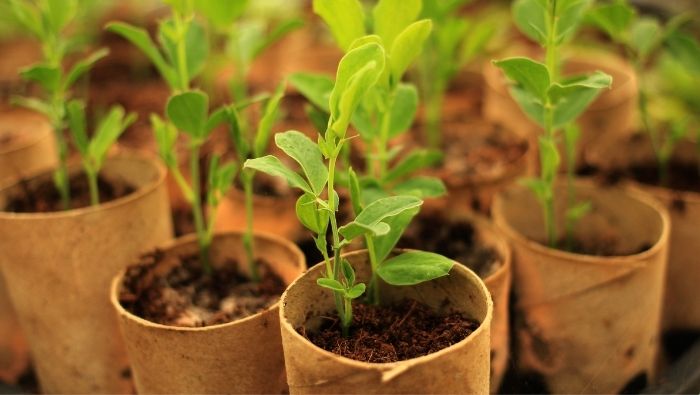Frugal Seed Starters for Cutting Gardening Costs

Spending big bucks on products for starting seeds isn’t necessary. Use these ideas to create your own frugal seed starters.
The gardener’s yearly urge to “dig in the dirt” doesn’t give you an excuse to dig into your savings to buy a host of new garden supplies.
Mini-greenhouses, seed-starting trays, and other fancy seed-starting products may be tempting, but frugal gardeners know that spending money on these products isn’t necessary. With a little effort, you can create your own seed-starting supplies at a fraction of the cost.
Newspaper Pots
You may not receive the newspaper any longer, but it is an excellent material for making cheap seed-starting pots. If your neighbor gets the paper, ask if you can have a stack of their old papers when they have finished with them. Otherwise, it might be worth buying a few papers depending on how many seed starters you intend to make.
Cut or tear the newspaper into four-inch strips and stack them into individual piles three to four layers thick. Lay a clean soup or juice can on top of the newspaper strips so that one inch of the strip extends below the bottom of the can. Roll the paper around the can and secure the overlap with tape. Fold the ends toward the bottom of the can, overlapping as necessary. Tape the ends in place and remove the can.
This creates a seed-starting pot for your seeds. When planting time comes, simply plant the seedling, pot, and all.
Sign Up for Savings
Subscribe to get money-saving content by email that can help you stretch your dollars further.
Twice each week, you'll receive articles and tips that can help you free up and keep more of your hard-earned money, even on the tightest of budgets.
We respect your privacy. Unsubscribe at any time.
Mini Greenhouses
Making mini greenhouses isn’t difficult and can be accomplished with recycled materials. Save deli containers or ask friends and neighbors to save them for you. Containers from cakes, pastries, or party platters work best, as they typically contain a large dome. Small sandwich containers or those from some fast-food restaurants work, too.
Fill the bottom of the container with soil or fill a shallow container slightly smaller than the plastic dome, and plant seeds as directed on the seed packet. Cover with the plastic dome to keep the soil moist and prevent evaporation.
Mini greenhouses speed germination and make keeping the soil moist a bit easier. Check the soil often and spray lightly if the soil begins to dry. If excessive moisture builds up or you notice signs of green mold on the soil, open the cover for several hours. This allows moisture to escape and improves aeration.
Covers should be removed once seedlings germinate to allow for air circulation.
Seed Tapes
You’ve probably seen seed tapes designed to roll out over the soil but couldn’t justify the added expense of purchasing these pre-sown seeds. The good news is that you can make them yourself for pennies.
Cut a section of paper towels to the desired size. Commercial brown towels work best, but any paper towel will do. For a single row of seeds, cut the paper towels in four-inch wide strips in the length you desire. For wider areas, you may wish to use the entire width of the towel. For areas larger than the width of the towel, it is best to make separate seed tapes and then lay them down in the desired pattern at planting time.
Determine the proper seed spacing for the type of seeds you are planting. You can find this information on the back of the seed packet. Measure and mark the seed placement on the paper towel.
Place a small dab of white craft or school glue on each marked point. Position one seed on each dot of glue. Allow the glue to dry completely. Roll the seed tape up and store it in a dark, dry place until planting time.
To plant, simply roll the seed tape out in the desired location and cover lightly with soil. Most small seeds require soil to a depth of 1/8 to 1/4 inch, while medium seeds may require a depth of 1/2 inch. Refer to the seed packet if you are unsure of the planting depth. Water to moisten the seed tape and keep it moist until seedlings appear.
Seed tapes work best with small to medium seeds.
Additional Seed Savings
- Buy a large container of peat moss and mix it with perlite to make your seed starter.
- Check discount stores for inexpensive seeds. Some large companies customarily sell seed packets returned from retail stores or those with damaged packaging at a deep discount.
- Watch for end-of-the-season sales and buy next year’s seeds in the fall. Most seeds continue to germinate well for several years.
- Swap seeds with a friend or neighbor. Seed packets often contain more than you can use. By swapping seeds with neighbors, you can get several varieties for the price of one seed packet.
- Store unused seeds in a cool, dark place.
- Always label seeds with both the variety and the date before storing. Although many thrive for several years, the germination rate decreases with each year. Typically, seeds remain viable for three to five years if stored properly.
Reviewed February 2024
Popular Articles
On After50Finances.com
- 9 Things You Need to Do Before You Retire
- You Didn’t Save Enough for Retirement and You’re 55+
- When Empty Nesters Reorganize and Declutter Their Home
- Reinventing Your Career in Your 50s or 60s
- What Mature Homeowners Should Know about Reverse Mortgages
- 2 Reasons to Collect Social Security Benefits As Soon As Possible

